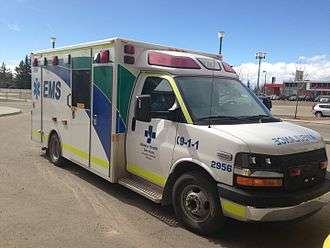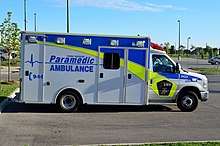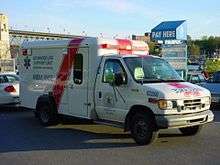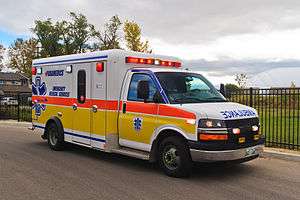Paramedics in Canada
A paramedic is a healthcare professional, providing pre-hospital assessment and medical care to people with acute illnesses or injuries. In Canada, the title paramedic generally refers to those who work on land ambulances or air ambulances providing paramedic services. Paramedics are increasingly being utilized in emergency rooms by providing patient care in collaboration with physicians, physician assistants, nurse practitioners, registered nurses, registered/licensed practical nurses and registered respiratory therapists. Increasingly in Canada, paramedics are actively pursuing self-regulation.





Training
Paramedic education, or the study of paramedicine in Canada, is an intensive academic program of formal theory and clinical experience which varies from province to province. For example, the primary care paramedic program may be eight months in class with 12 days on the ambulance for precepting (British Columbia),[1] twelve months in Manitoba[2] or a three-year advanced diploma or four year bachelor's degree in primary care paramedicine in Ontario.[3]
Training as an advanced care paramedic (ACP) requires that the student be first registered as a primary care paramedic. Eligibility for ACP training varies from immediate entry following PCP registration to a mandatory period of experience working as a PCP for usually one to three years. The length of time required to complete ACP training also varies between provinces, and it is generally inversely related to the length of time required to have completed the prerequisite PCP training. Shorter (around one year) programs build upon the education already learned in a two-year PCP training program, while longer (typically up to two years) college programs typically cater to PCP who graduated from shorter PCP programs.
Thus, while there is continual debate on the merits of longer or shorter PCP programs (often centered around teaching philosophy), in common, ACPs across Canada will generally have completed approximately three years of intensive formal education, inclusive of didactic study and clinical placements. There are two Bachelor of Health Science in paramedicine degrees currently available in Canada and are becoming the standard of paramedic education as the profession progresses at the Primary Care Paramedic entry level. This would be comparable to when nursing moved from the college based program to the collaborative or university based program in Canada. These programs are often offered through partnerships between Canadian universities and colleges, blending vocational training with higher education.[4]
The accreditation of paramedic educational programs in Canada also varies from province to province. The Canadian Medical Association's Committee on Conjoint Accreditation offers the most comprehensive and best known system of national accreditation.[5] Their accreditation model is an independent body, and draws from The "National Occupational Competency Profile" as the benchmark document that details the knowledge, skills and abilities outcomes that must be possessed by practitioners of each respective level of paramedic practice.
Paramedicine training in Quebec
Paramedicine training in the province of Quebec has been standardized and now requires all new paramedics to hold a three-year Diploma of College Studies in Emergency Prehospital Care, or Soins préhospitaliers d'urgence (SPU) in French, from a recognized CEGEP program. Upon completion of this diploma and passation of the provincial examination, one is certified at the level of primary care paramedic (PCP). Since 2015, a formal 2-year advanced care paramedic (ACP) training program was developed at Université de Montréal for experienced PCPs from Urgences-santé.
Types of paramedics
In Canada the scope of practice of paramedics is described by the National Occupational Competency Profile (NOCP) for Paramedics[6] document developed by the Paramedic Association of Canada with financial support from the Government of Canada. The NOCP outlines four provider levels: Emergency Medical Responder (EMR), Primary Care Paramedic (PCP), Advanced Care Paramedic (ACP), and Critical Care Paramedic (CCP)
Provincial variations on the National Occupational Competency Profile
Of considerable relevance to understanding the nature of Canadian paramedic practice, the reader must appreciate the considerable degree of inter-provincial variation. Although a national consensus (by way of the National Occupational Competency Profile) identifies certain knowledge, skills, and abilities as being most synonymous with a given level of paramedic practice, each province retains ultimate authority in legislating the actual administration and delivery of emergency medical services within its own borders. For this reason, any discussion of paramedic practice in Canada is necessarily broad, and general. Specific regulatory frameworks and questions related to paramedic practice can only definitively be answered by consulting relevant provincial legislation, although provincial paramedic associations may often offer a simpler overview of this topic when it is restricted to a province-by-province basis.
Regulatory frameworks vary from province to province, and include direct government regulation (such as Ontario's method of credentialing its practitioners with the title of A-EMCA, or Advanced Emergency Medical Care Attendant)[7] to professional self-regulating bodies, such as the Alberta College of Paramedics. Though the title of paramedic is a generic description of a category of practitioners, provincial variability in regulatory methods accounts for ongoing differences in actual titles that are ascribed to different levels of practitioners. For example, the province of British Columbia is the only province that uses the title "Infant Transport Team Paramedic", or 'ITT Paramedic' for PCPs who have received additional critical care training for paediatric, neonatal, and high risk obstetric emergencies.[8] All provinces, however, have moved to standard titles, or have at least recognized the NOCP document as a benchmark document to permit inter-provincial labour mobility of practitioners, regardless of how titles are specifically regulated within their own provincial systems.
Emergency medical responder (EMR)
This is a level of practice recognized under the National Occupational Competency Profile and the Paramedic Association of Canada. As a group, EMRs staff rural ambulance stations, patient transfer services, community medical event coverage, industrial ambulances or mobile treatment centres. For many small communities, without this level of certification, the operation of a much-needed community ambulance system might not be possible. EMRs working as first responders in fire departments, police departments and institutions across Canada contribute an important role in the chain of survival. It is a level of practice focused primarily on life saving methods and is generally consistent with fewer acts beyond advanced first-aid and is the entry to practice leading to higher paramedic practice. Their scope of practices include oxygen administration, oropharyngeal and nasopharyngeal airway adjuncts, the use and interpretation of a pulse oximeter, use and interpretation of a glucometer, blood pressure assessment by auscultation and palpation, chest auscultation, oropharyngeal airway suctioning, administration of the following oral, sublingual or inhaled medications: anti-anginal, anti-hypoglycemic agent, analgesia, platelet inhibitors (including nitroglycerin, glucose, nitrous oxide, acetylsalicylic acid, salbutamol, intravenous lines without medications or blood products).[9] EMRs may administer naloxone and epinephrine by injection, and use automated external defibrillation, which are still regulated medical acts in Canada, although they are increasingly delegated to the general public.
Primary care paramedic (PCP)
Primary care paramedics (PCPs) are the entry level of paramedic practice across Canada. The scope of practice includes performing semi-automated external defibrillation, manual defibrillation, oxygen administration, ETCO2 monitoring, supraglottic airways, vascular access, cardiac monitoring such as Lead 2 interpretation and 12 Lead acquisition and interpretation, and administration of Symptom Relief Medications for a variety of emergency medical conditions (these include epinephrine, salbutamol, ipratropium bromide, aspirin, nitroglycerine, naloxone, dextrose, glucagon, gravol, ketorolac, ibuprofen, acetaminophen, benadryl). PCPs may also receive additional authorization in order to perform certain skills that are normally in the scope of practice of ACPs.
Advanced care paramedic (ACP)
The Advanced Care Paramedic is a level of practitioner that is in high demand by many services across Canada. The ACP typically carries approximately 20 different medications, although the number and type of medications may vary substantially from region to region. ACPs perform advanced airway management including intubation, surgical airways, intravenous therapy, place external jugular IV lines, perform needle thoracostomy, perform and interpret 12-lead ECGs, perform synchronized and chemical cardioversion, transcutaneous pacing, perform obstetrical assessments, and provide pharmacological pain relief for various conditions. Several sites in Canada have adopted pre-hospital fibrinolytics and rapid sequence induction, and prehospital medical research has permitted a great number of variations in the scope of practice for ACPs.
Current bypass protocols include providing both PCPs and ACPs with discretionary direct 24-hour access to PCI labs, bypassing the emergency department, and representing a fundamental change in both the way that patients with S-T segment elevation myocardial infarctions (STEMI) are treated, but also profoundly affecting survival rates.[10] as well as bypassing a closer hospitals to get an identified stroke patient to a stroke centre.
Specialized paramedics
Training for specialization as a paramedic is most often provided by employers who select paramedics that have gone through an internal competition. There are very few specialization education programs open to the public currently.
Most specializations require the applicant to already be an experienced advanced care paramedic.
Critical care paramedic (CCP)
Critical care paramedics' expertise focus on critical and ICU level care, stabilizing and transporting patients from smaller hospitals with less available resources to tertiary care, and regional medical programs in to other hospitals that can provide a higher level of care. CCPs generally work with an ACP, registered nurse, physician, or another CCP. Sometimes ad hoc teams, with multiple practitioners (RTs, emergency physicians, surgeons, etc.) are assembled for certain patients.
CCPs are able to provide all of the care that PCPs and ACPs provide. In addition to this they are trained for other skills such as medication infusion pumps, mechanical ventilation and arterial line monitoring.[11]
CCPs often work in fixed and rotary wing aircraft when the weather permits and staff are available, but systems such as the Toronto EMS Critical Care Transport Program work in land ambulances. ORNGE Transport operates both land and aircraft in Ontario. In British Columbia, CCP's work primarily in aircraft with a dedicated Critical Care Transport crew in several cities for long-distance/high acuity transfers and as regular CCP street crews who may do major trauma calls or, performs medevacs, when necessary.
Across the prairies, STARS Shock Trauma Air Rescue Society uses rotary wing aircraft to reach many in isolated communities and traumatic situations for faster response time than by ground ambulance.[12] In Saskatchewan they also use fixed wing air ambulances. The service, called LIFEGUARD, can respond a greater distance and to more northern communities than STARS. Sask air ambulance service was the first non-military air ambulance service in the world.[13] These air ambulances are crewed by Flight Nurses and CCPs.
Tactical paramedic
Tactical paramedics are specialized paramedics who undergo additional training to allow them to perform their usual task in a high risk and dangerous scenario. Some are trained to handle weapons, rappel from buildings and other skills needed to work alongside tactical police units.[14]
These paramedics are required to wear protective gear but are unarmed.
Occupational health paramedic
Occupational health paramedics work closely with occupational physicians and nurses to help with pre-employment screening, medical surveillance programs and clinical testing for companies.
Community paramedic
The newest level/role for paramedics in Canada, community paramedics work in clinics, hospitals, and in patient's homes. They provide immediate or scheduled primary, urgent and specialized healthcare to vulnerable patient populations by collaborating with other healthcare providers, conducting assessments, treating, and doing/ordering tests.[15]
Diagnostics provided by Community Paramedics: Specimen collection (blood, urine, swabs), 12/15 lead ECGs, vital signs (temperature, blood glucose, SPO2, side stream CO2, BP), and facilitate transports for diagnostic imaging.
Treatments provided by Community Paramedics: CVC & IV rehydration, blood transfusions, urinary catheterization, wound closure & care (tissue adhesive, sutures, dressings), oxygen and nebulizer therapy, IV/SQ/IM/PO/PORT/PICC medication administration (including IV antibiotics), and coordination of community services.[16]
Incident response paramedic
A type of specialisation in Alberta Metro areas, IRPs receive intensive training, including toxicology, hazmat chemistry, National Fire Protection Association hazmat awareness and operations certifications, as well as three weeks of CBRNE training, antidote, medical countermeasures, MCI, and protective equipment training.
For day-to-day operations, IRPs respond to hazmat- and toxicology-related incidents. They carry a wider range of medications than advanced care paramedics and more protective equipment, allowing them to better treat poisonings/overdoses and work closely with firefighters and hazmat technicians.[17]
Paramedic specialist
ACPs and CCPs in British Columbia that provide on-scene technical support for high-risk situations, mass and complex patient events as well as telephone support to paramedics and patients. Additionally, Paramedic Specialists will provide ALS backup for PCP ambulances and will sometimes be the first unit on-scene at calls. Typically work in solo response vehicles in Metro areas or in dispatch centres.
Infant transport team paramedic
Only a designation in British Columbia, ITT paramedics are specially trained critical care paramedics who undergo extra training to provide emergency medical care for BC pediatric, neo-natal and high-risk obstetrics patients while en route to specialized care units in hospitals throughout British Columbia, the Yukon Territories, other parts of Canada and the United States as required.
The ITT is the only specialized paramedic team in the world who serves three distinct patient groups.[18]
Medical direction and oversight
In some of Canada, paramedics do not work under their own medical license. Some exceptions are in British Columbia, New Brunswick, Nova Scotia, Saskatchewan and Alberta where each paramedic regardless of level, has their own license to practice.[19] In Ontario, paramedics are permitted to perform regulated medical acts by the process of 'delegation'. This means that one physician, known as the medical director, has become familiar with the individual paramedic and then has delegated authority to that paramedic which allows them to perform specific regulated medical act under defined situations. The scope of practice for the paramedic is defined in paramedic protocols (also referred to as advanced medical directives). These protocols specify which skill and the conditions required for the paramedic to act. Each protocol is signed by the medical director. Medical directors are generally ER physicians who work in a hospital associated with the paramedic service. The relationship between this hospital ('Base Hospital') is formalized through legal agreements. Other physicians in the base hospital who are allowed to give direct orders to paramedics that exceed their protocols (often via telephone) are referred to as delegating physicians. These physicians are usually ER physicians.
Some Canadian paramedics are moving towards the status of self-regulated health professionals with paramedics forming their own professional colleges in much the same manner as nurses and other health professions, the most recent being Nova Scotia launching in 2017. These organizations are responsible to the government for the examination and licensing of practitioners, the establishment of standards of practice, the investigation of public complaints against members, and the disciplining of members. They are also required to advise the government on all issues and legislation related to the practice of their members. Following the example of their British colleagues,[20] Colleges or Associations have been established in Alberta,[21] Saskatchewan,[22] Manitoba, New Brunswick,[23] and Nova Scotia,[24] with Ontario[25] actively moving towards this type of legislation.
Professional environment
Paramedics have a close relationship with the physicians who (in most systems) grant paramedics the legal right to practice their profession with a regulated paramedic service. Some systems in Canada are transitioning to a self regulated organization, where medical authority derives directly from legislation and self-regulation rather than the approval of a medical doctor. Also, because physician assistants in Canada exist primarily in the Canadian Forces, the role of clinical paramedic practitioners is under serious study.[26] Both urban and rural centres have begun utilizing paramedics working in-hospital on cardiac arrest teams, patient transfer teams, emergency department triage/treatment and to facilitate faster "off-load" times.
In Halifax, NS, ACPs and PCPs work side by side with physicians in various emergency departments within the Capital District Health Authority. The responsibilities of these department paramedics varies from ER to ER within CDHA but include advanced airway stabilization, suturing, minor treatment as well as other expanded paramedic roles such as procedural sedations. They have also proven a necessary and integral member of the cardiac arrest and trauma teams. PCPs have been employed by CDHA since the early 1990s to perform triage assessments.
Paramedics often work long hours; with a variety of 8-, 10-, 12- and 14-hour shifts. In some areas, however, 24- and even 96-hour shifts are not unusual. Salary and benefits are generally commensurate with the level of education and certification, though often less than the salary expectations of police officers and firefighters. This incongruity is often argued as being unfair, especially in light of the relative level of responsibility a paramedic may have for acting decisively and without having direct supervision. However, many paramedics consider their career to offer intangible benefits and reported job satisfaction is generally high. Due to the challenging working conditions, paramedics, similarly to other first responders, are at a greatly increased risk to develop Post-Traumatic Stress Disorder as compared to the general population.[27]
Paramedics in Canada generally work only as paramedics, but occasionally are cross-trained as firefighters, security contractor, search and rescue or law enforcement officers, and most are paid full or part-time professionals. In the first quarter of 2005, paramedics were granted status federally as a "Public Safety Occupation" which means that paramedics are now eligible for early retirement, as are police officers and fire fighters.[28] Many EMS agencies run a full range of paramedic specialty squads including: Marine medics, Bike medics, First Response medics, Tactical ERT & CCU medics, CBRNe medics (Chemical, Biological, Radiological, Nuclear and Explosive) and USAR medics (Urban Search And Rescue - specializing in urban disaster rescue recovery) and finally NOHERT medics (members of Provincial or regional Health Emergency Response Teams)
Salary and employment
Paramedic wages in Canada vary depending on province and experience, but a "typical full-time annual salary for this occupation is in the region of $45,000 – $65,000."[29] However, some jurisdictions and special qualifications provide far greater salaries: Paramedics in Ontario have an annual salary starting from $70,000 to $90,000 as a Primary Care Paramedic, an Advanced Care Paramedic's salary can on average range from $80,000 to $100,000, and Critical Care Paramedics range from $100,00 to $135,000. Education background, experience, and level of practice all are contributing factors to which salary is established. [30]
See also
References
- "Primary Care Paramedic | Justice Institute of British Columbia". Retrieved 2017-01-08.
- "Paramedicine - Primary Care Paramedicine". me.rrc.mb.ca.
- "John Abbot to offer paramedic training (Montreal Gazette story)". Retrieved 2008-11-14.
- "Paramedic Bridging to University (Centennial College website)". Retrieved 2008-11-14.
- "Canadian Medical Association's Conjoint Accreditation Services". Retrieved 2008-02-15.
- "National Occupational Competency Profile". Retrieved 2008-02-15.
- "Ambulance Act, Revised Statutes of Ontario, 1990". Retrieved 2008-11-14.
- "Infant Transport Team". www.bcehs.ca.
- "Emergency Medical Assistants Regulation". www.bclaws.ca.
- +Le May MR, So DY, Dionne R, Glover CA, Froeschl M, Wells GA, Davies RF, Sherrard HL, Maloney J, Marquis, J-F, O'Brien ER, Trickett J, Poirier P, Ryan S, Ha A, Joseph PG, and Labinaz M. (2008). "A Citywide Protocol for Primary PCI in ST-Segment Elevation Myocardial Infarction". NEJM. 358 (3): 231–240. doi:10.1056/NEJMoa073102. PMID 18199862.CS1 maint: multiple names: authors list (link)
- https://www.olatechcorp.com, OlaTech Corp. "Paramedic Association of Canada". Paramedic Association of Canada.
- "STARS air ambulance". STARS Air Ambulance.
- "HealthLine - Accessing Health Care Services in Saskatchewan - Government of Saskatchewan". Government of Saskatchewan.
- "Simcoe County News - Latest Daily Breaking News Stories - Simcoe.com". Simcoe.com.
- Services, Alberta Health. "Community Paramedics - Alberta Health Services". Alberta Health Services.
- Services, Alberta Health. "Calgary Zone Community Paramedic Program - Alberta Health Services". Alberta Health Services.
- "Paramedics To The Response".
- "Infant Transport Team". www.bcehs.ca.
- "Emergency Medical Assistants Licensing Board". Retrieved 2008-11-14.
- "British College of Paramedics". Retrieved 2008-11-14.
- "Alberta College of Paramedics". Retrieved 2008-11-13.
- "Saskatchewan College of Paramedics". Retrieved 2008-11-13.
- "Paramedic Association of New Brunswick". Retrieved 2010-01-26.
- "Nova Scotia Paramedic Society". Retrieved 2013-11-13.
- "College update". Retrieved 2008-11-13.
- Garza M (2007). "Community Paramedics Make House Calls". JEMS. 32 (9).
- http://vernon.cmha.bc.ca/get-informed/mental-health-information/ptsd
- "Budget provides pension fairness for public safety officers". Retrieved 2008-11-14.
- "Paramedic Salary Canada". www.livingin-canada.com.
- "Paramedic Salary Canada". www.livingin-canada.com.
External links
- Paramedic Association of Canada
- Paramedic Association of Manitoba
- Peel Paramedic Association (Ontario)
- Paramedic Association of New Brunswick
- Emergency Medical Care Inc. (Nova Scotia)
- Paramedic Association of Newfoundland and Labrador
- Alberta College of Paramedics
- National Registry of Emergency Medical Technicians
- National Association of Emergency Medical Technicians
- NHTSA Emergency Medical Services National Page
- Association Professionnelle des Paramédics du Québec
- Nova Scotia Paramedic Society
- http://www.collegeofparamedics.sk.ca